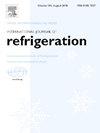Detailed study of a condensation-driven dilution refrigerator reaching below 50 mK
IF 3.5
2区 工程技术
Q1 ENGINEERING, MECHANICAL
International Journal of Refrigeration-revue Internationale Du Froid
Pub Date : 2025-02-14
DOI:10.1016/j.ijrefrig.2025.02.016
引用次数: 0
Abstract
The condensation-driven dilution refrigerator employs a condensation pump to accomplish the circulation of 3He, offering advantages such as compactness, lightweight, and low cost. In our previous work, we constructed a prototype with a lowest temperature of around 60 mK, yet the system performance needs further improvement. In this paper, we present our latest advances. By adding a step heat exchanger made from sintered silver powder and reducing heat leakage in the system, a lowest temperature of 45 mK, a maximum cooling power of 8.4 μW @100 mK, and a corresponding thermodynamic degree of perfection of 11.28 % is achieved in the experiments. A comprehensive numerical model of the condensation-driven dilution refrigerator has been developed. The results of experiments and simulations are compared and analyzed, revealing the influence of key parameters on the system performance. Firstly, the efficiency is significantly related to the temperature of the mixing chamber, still, and condensation pump. The entropy generation analysis is conducted, and it is found that the contribution of the still to the total entropy production always remains predominant. Secondly, to circulate the 3He, the vapor pressure above the still should be greater than the saturated vapor pressure corresponding to the condensation pump temperature. This imposes a requirement on both the still and condensation pump temperatures to activate the dilution cycle with a certain mixing chamber temperature. Finally, the comparison between the experiments and simulations indicates a maximum cooling power exists at a certain high still temperature as the other conditions are kept the same. With the help of the simulation, the internal dynamic and thermodynamic characteristics during operation have been clarified, which can guide further optimizations.
50 mK以下冷凝驱动稀释制冷机的详细研究
冷凝驱动稀释制冷机采用冷凝泵来完成3He的循环,具有体积小、重量轻、成本低等优点。在我们之前的工作中,我们构建了一个最低温度约为60 mK的原型,但系统性能需要进一步改进。在本文中,我们介绍了我们的最新进展。通过加入烧结银粉制成的阶梯换热器,减少系统的热泄漏,实验温度最低为45 mK,最大冷却功率为8.4 μW @100 mK,相应的热力学完美度为11.28%。建立了冷凝驱动稀释制冷机的综合数值模型。对实验和仿真结果进行了对比分析,揭示了关键参数对系统性能的影响。首先,效率与混合室、蒸馏器和冷凝泵的温度显著相关。进行了熵产分析,发现蒸馏器对总熵产的贡献始终占主导地位。其次,要使3He循环,蒸馏器上方的蒸汽压应大于冷凝泵温度对应的饱和蒸汽压。这对蒸馏器和冷凝泵的温度都提出了要求,以便在一定的混合室温度下激活稀释循环。最后,将实验与仿真结果进行了比较,结果表明,在其他条件相同的情况下,在一定的高静止温度下存在最大冷却功率。通过仿真,明确了运行过程中的内部动力学和热力学特性,为进一步优化提供了指导。
本文章由计算机程序翻译,如有差异,请以英文原文为准。
求助全文
约1分钟内获得全文
求助全文
来源期刊
CiteScore
7.30
自引率
12.80%
发文量
363
审稿时长
3.7 months
期刊介绍:
The International Journal of Refrigeration is published for the International Institute of Refrigeration (IIR) by Elsevier. It is essential reading for all those wishing to keep abreast of research and industrial news in refrigeration, air conditioning and associated fields. This is particularly important in these times of rapid introduction of alternative refrigerants and the emergence of new technology. The journal has published special issues on alternative refrigerants and novel topics in the field of boiling, condensation, heat pumps, food refrigeration, carbon dioxide, ammonia, hydrocarbons, magnetic refrigeration at room temperature, sorptive cooling, phase change materials and slurries, ejector technology, compressors, and solar cooling.
As well as original research papers the International Journal of Refrigeration also includes review articles, papers presented at IIR conferences, short reports and letters describing preliminary results and experimental details, and letters to the Editor on recent areas of discussion and controversy. Other features include forthcoming events, conference reports and book reviews.
Papers are published in either English or French with the IIR news section in both languages.

 求助内容:
求助内容: 应助结果提醒方式:
应助结果提醒方式:


